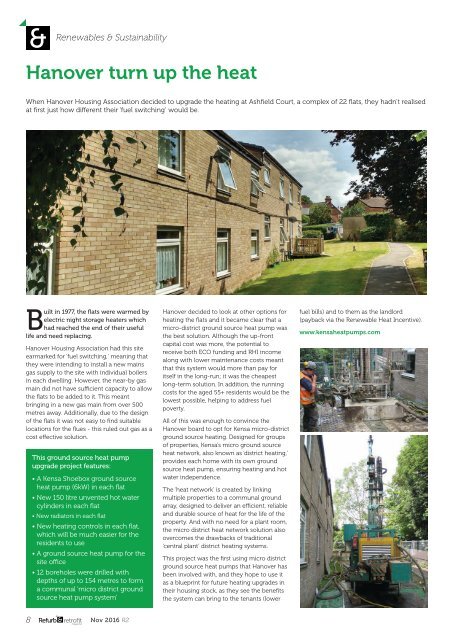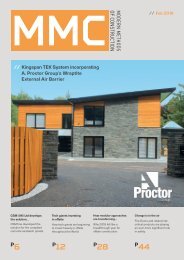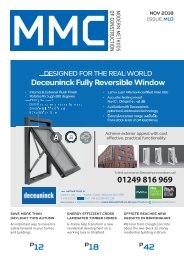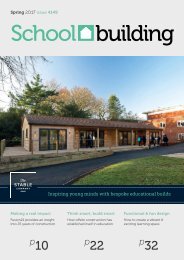November Refurb and Retrofit Magazine
Create successful ePaper yourself
Turn your PDF publications into a flip-book with our unique Google optimized e-Paper software.
Renewables & Sustainability<br />
Hanover turn up the heat<br />
When Hanover Housing Association decided to upgrade the heating at Ashfield Court, a complex of 22 flats, they hadn’t realised<br />
at first just how different their ‘fuel switching’ would be.<br />
Built in 1977, the flats were warmed by<br />
electric night storage heaters which<br />
had reached the end of their useful<br />
life <strong>and</strong> need replacing.<br />
Hanover Housing Association had this site<br />
earmarked for ‘fuel switching,’ meaning that<br />
they were intending to install a new mains<br />
gas supply to the site with individual boilers<br />
in each dwelling. However, the near-by gas<br />
main did not have sufficient capacity to allow<br />
the flats to be added to it. This meant<br />
bringing in a new gas main from over 500<br />
metres away. Additionally, due to the design<br />
of the flats it was not easy to find suitable<br />
locations for the flues - this ruled out gas as a<br />
cost effective solution.<br />
This ground source heat pump<br />
upgrade project features:<br />
• A Kensa Shoebox ground source<br />
heat pump (6kW) in each flat<br />
• New 150 litre unvented hot water<br />
cylinders in each flat<br />
• New radiators in each flat<br />
• New heating controls in each flat,<br />
which will be much easier for the<br />
residents to use<br />
• A ground source heat pump for the<br />
site office<br />
• 12 boreholes were drilled with<br />
depths of up to 154 metres to form<br />
a communal ‘micro district ground<br />
source heat pump system’<br />
Hanover decided to look at other options for<br />
heating the flats <strong>and</strong> it became clear that a<br />
micro-district ground source heat pump was<br />
the best solution. Although the up-front<br />
capital cost was more, the potential to<br />
receive both ECO funding <strong>and</strong> RHI income<br />
along with lower maintenance costs meant<br />
that this system would more than pay for<br />
itself in the long-run; it was the cheapest<br />
long-term solution. In addition, the running<br />
costs for the aged 55+ residents would be the<br />
lowest possible, helping to address fuel<br />
poverty.<br />
All of this was enough to convince the<br />
Hanover board to opt for Kensa micro-district<br />
ground source heating. Designed for groups<br />
of properties, Kensa’s micro ground source<br />
heat network, also known as ‘district heating,’<br />
provides each home with its own ground<br />
source heat pump, ensuring heating <strong>and</strong> hot<br />
water independence.<br />
The ‘heat network’ is created by linking<br />
multiple properties to a communal ground<br />
array, designed to deliver an efficient, reliable<br />
<strong>and</strong> durable source of heat for the life of the<br />
property. And with no need for a plant room,<br />
the micro district heat network solution also<br />
overcomes the drawbacks of traditional<br />
‘central plant’ district heating systems.<br />
This project was the first using micro district<br />
ground source heat pumps that Hanover has<br />
been involved with, <strong>and</strong> they hope to use it<br />
as a blueprint for future heating upgrades in<br />
their housing stock, as they see the benefits<br />
the system can bring to the tenants (lower<br />
fuel bills) <strong>and</strong> to them as the l<strong>and</strong>lord<br />
(payback via the Renewable Heat Incentive).<br />
www.kensaheatpumps.com<br />
8 <strong>Refurb</strong> retrofit<br />
magazine<br />
Nov 2016 R2

















